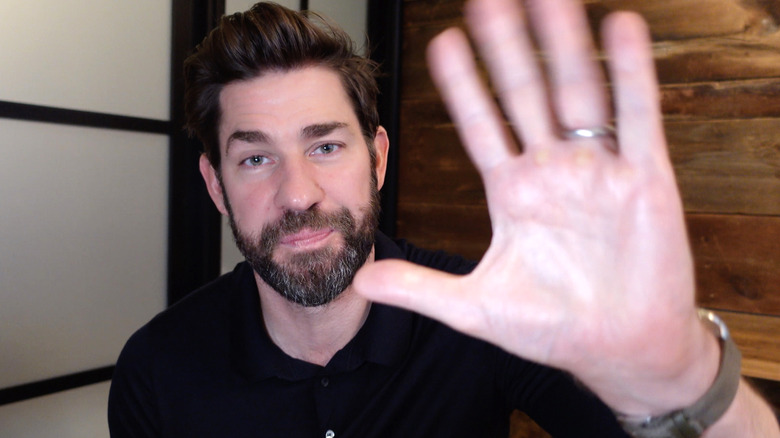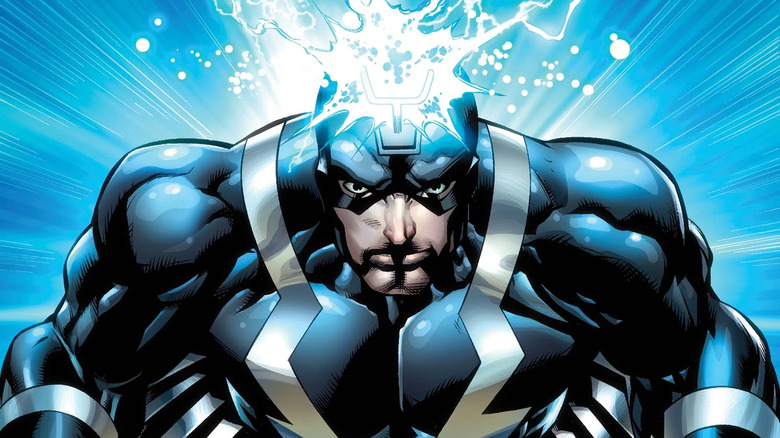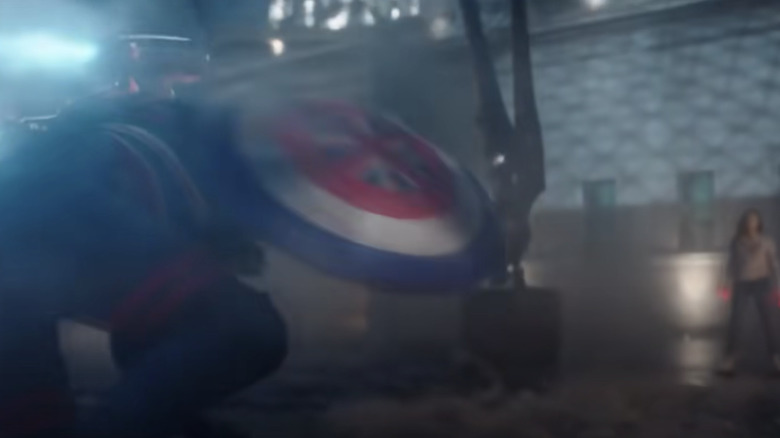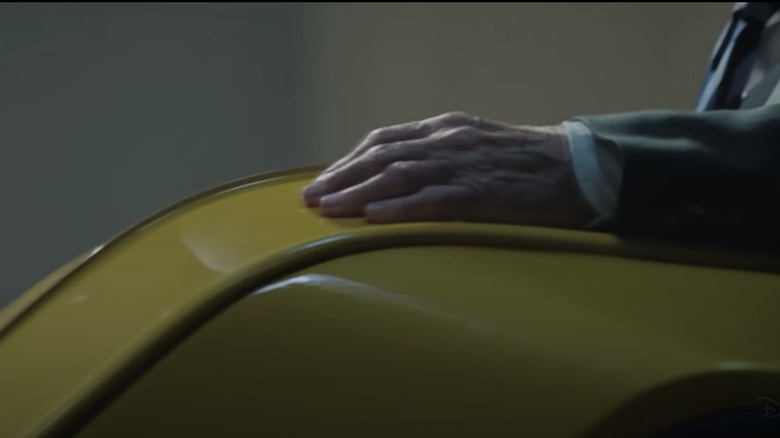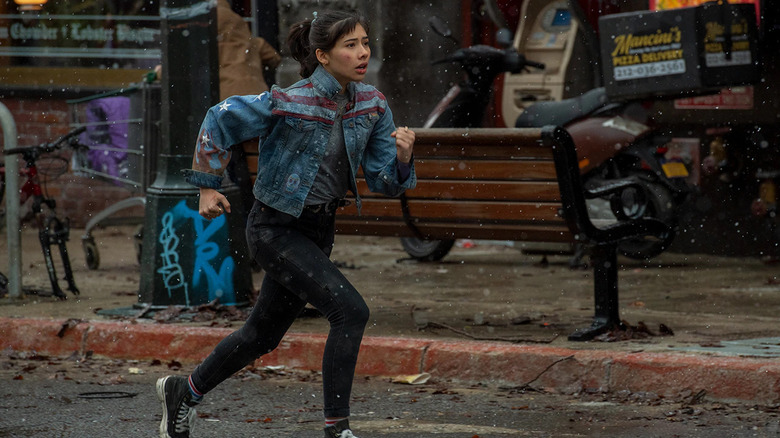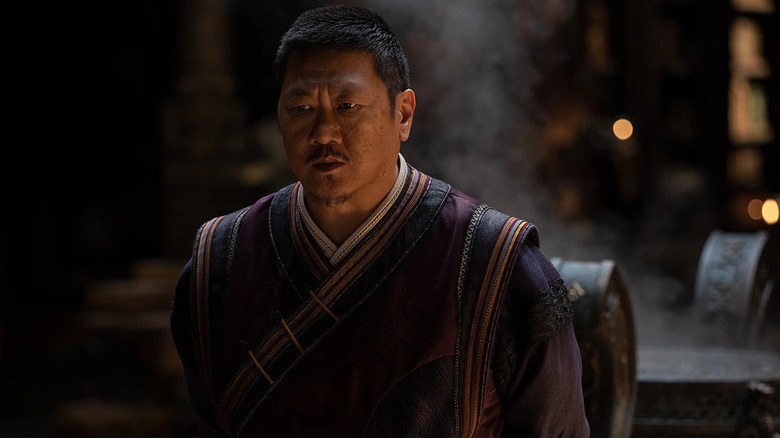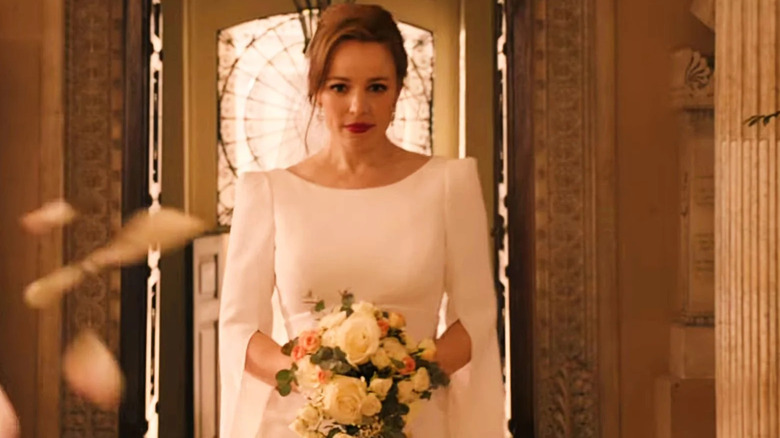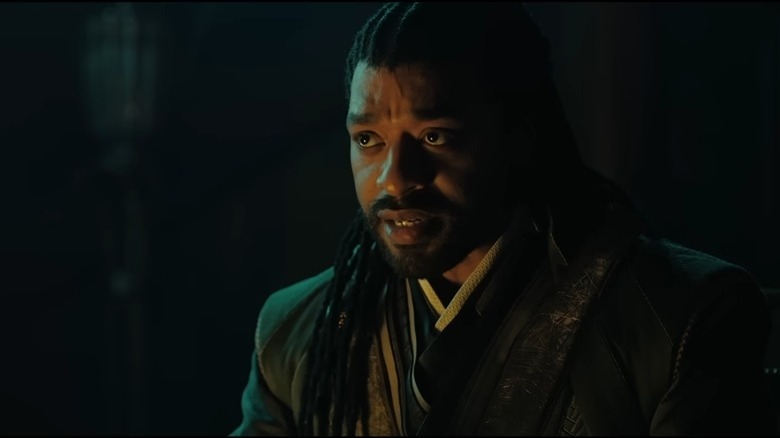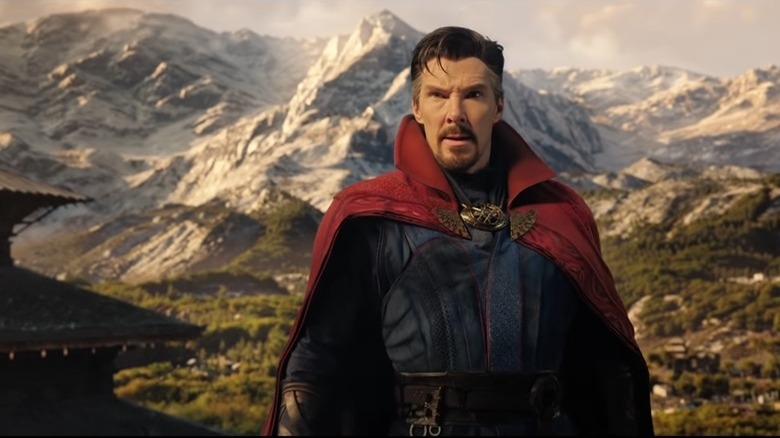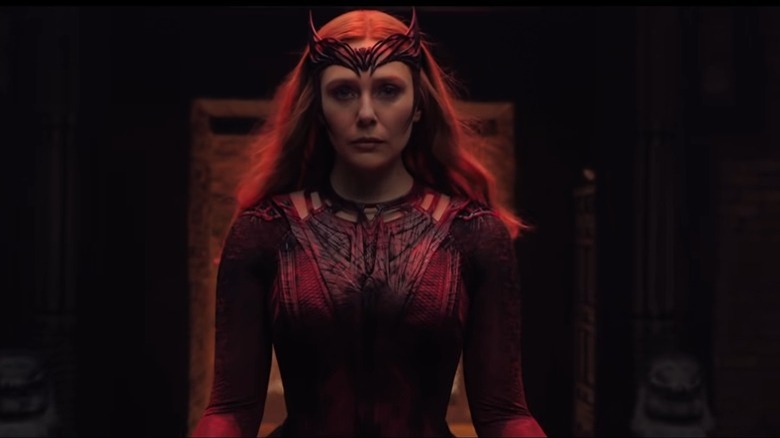The Best Performances In Doctor Strange In The Multiverse Of Madness, Ranked
While reviews have been more mixed for "Doctor Strange in the Multiverse of Madness" than its predecessor, it cruised to a larger box office haul with a massive opening weekend. Much of the praise for the film has been focused on Sam Raimi's first superhero film since "Spider-Man 3" in 2007 and his first directing effort since 2013's "Oz the Great and Powerful." The film crackles with more Raimi-isms than fans have probably seen since "Spider-Man 2" moments like the Doctor Octopus arm surgery scene.
However, the film also boasts a bevy of characters that earned hoots and hollers in theaters. There are newly-introduced favorites, heroes with impressive cult followings, and established MCU Avengers introducing new takes on familiar faces. So how do the actors portraying those iconic characters and recent Marvel heroes fare when compared to one another? Read on to read to find out.
11. Mister Fantastic
John Krasinski has long been one of the top fan choices for Reed Richards, so there is a thrill to seeing fantasy transition into reality. However, just because the fans want something doesn't always make it the right call. Not every realization of fans' hopes ends up as well as Patrick Stewart's work as Professor Charles Xavier, for instance.
There's a certain awkwardness in Krasinski's performance here. Part of it seems to be the costume, which is at least partially CGI. There's a stiffness to it. Unfortunately, that rigidity is not meant as a metaphor for Richards' own inflexibility with Dr. Strange. There also isn't much about this character that feels particularly Mister Fantastic. Krasinski gets the cadence and presentation well enough, but there's none of the super-science or hunger for knowledge that usually marks the Fantastic Four's leader. In fact, the most memorable thing this "super-genius" does is absent-mindedly tip-off Scarlet Witch to Black Bolt's lethal superpower, allowing her to counter it.
One could argue that this is, in part, because this isn't our universe's Mister Fantastic, merely a multiverse variant. That's fair enough, but the end result still leaves the viewer with a performance that falls short of anticipated results.
10. Captain Marvel
In the Illuminati of "Doctor Strange in the Multiverse of Madness," Carol (Brie Larson) either never assumed the role of Captain Marvel or her best friend Maria Rambeau (Lashana Lynch) took it over after some sort of tragedy. That lack of a backstory makes sense in the context of the movie, but undermines the performance.
Lynch's Maria had her own personality in "Captain Marvel," and it largely isn't present here. Instead, she more closely resembles Carol's take on the character. Perhaps that suggests a similar "awakening" process for Rambeau, transitioning from Kree soldier naively buying what she's been told to realizing both her Earthly origins and how she's been misled. However, without any hint of that history, Lynch is so different from her main MCU incarnation that it might as well have been a completely different actor.
That said, her last stand is well done. Told mainly through facial expressions, the audience watches confidence move to grim determination before ending finally with a brief moment of fear. Viewers might not understand precisely who this Captain Marvel is or how she came to be, but that bit of work says all we need to know about her end.
9. Black Bolt
The television series "Inhumans" has gone down in history as arguably Marvel Studios' biggest failure. First announced as a film, it bounced around in production limbo before finally emerging as a half-hearted television show released with very little fanfare. Unfortunately, moving to the small screen failed to make the story of one of Marvel's most obscure subsets of characters any more palatable to critics or audiences.
It's amazing what a difference a costume can make. Anson Mount returns to the role of Blackagar Boltagon (aka Black Bolt) with slight cosmetic differences besides the addition of Bolt's signature headgear. And yet, he seems about two hundred percent more comfortable in the role.
It would be a mistake to overpraise a performance of such limited screen time, but it helps viewers see for the first time why Mount was a good casting decision stuck in a bad show. He has a presence that he never found its footing in "Inhumans." Mount also gives him a vaguely sinister arrogance that was nowhere in the earlier effort. His smirk when confronting Scarlet Witch, even if it is quickly erased, says more in a split second than was portrayed in 8 episodes.
8. Captain Carter
It's a fun performance that echoes Chris Evans' Captain America without stooping to straightforward imitation. Peggy (Hayley Atwell) evoking the "I can do this all day" catchphrase is smile-worthy, but she puts her own decidedly unique spin on it. She finds the difference between Rogers' doggedness and Carter's confident commitment, which is no easy trick in just one line. Her poise and response to Doctor Strange further suggest that she's been a decidedly less optimistic Captain than Rogers was while throwing the shield in modern times.
The performance is more impressive for viewers familiar with her work as Peggy Carter; Atwell has a different way of standing and wields distinct mannerisms as Captain Carter. They subtly suggest how this dissimilar path changed her without rendering her entirely unrecognizable.
Seeing a version of Captain Carter in "What If...?" was probably an advantage for the character's appearance here. Nonetheless, Atwell's performance is well-drawn enough to have worked with or without that animated prelude to her live-action incarnation.
7. Professor X
Patrick Stewart could likely play Professor X half asleep and still "get" the character at this point, but he seems fully engaged here. As the one member of the Illuminati not inclined to condemn Doctor Strange purely on their universe's version of the character, Stewart gives this Charles Xavier a contrasting warmth. He's kind and thoughtful while greeting Stephen as a person, not just a living threat.
Stewart does come with a notable advantage, however, having played this character in several films over the years, including depicting a younger version of himself in "X-Men 3: The Final Stand" and a Professor X nearing death in "Logan." That has given him plenty of time to get accustomed to playing the character — and the audience plenty of time to know, love and imbue his Professor X with goodwill.
Still, the proof is in the pudding. When it comes to Xavier, Stewart continues to deliver an empathetic performance that finds him earnestly trying to save the day in a kind, ethical manner.
6. America Chavez
So much of the role for America (Xochitl Gomez) is running and screaming at various volumes that it can be hard to craft a cogent character. In the wrong hands, it could easily make the character feel more like a plot point than an actual breathing person.
Thankfully, Gomez makes the best of her limited moments of quiet and conversation to give viewers a feel for America. The showcase is clearly when she and Strange debate her role in the disappearance of her mothers. Without lapsing into melodrama, she conveys the pain and guilt she's been carrying from world to world for more than half her life.
She's also appealing in less heavy scenes. For example, motoring through pizza slices while trying to explain what she knows of the multiverse to Wong and Doctor Strange or briefly playing expert on norms of other Earths before running afoul of Pizza Poppa (favorite Raimi accomplish Bruce Campbell).
Ultimately, the part does end up being a lot of running and screaming and damsel-in-distressing. However, there is lots of promise in Gomez's performance. If the MCU can find a place for Gomez to express more of America's personality, she could make for an exciting addition to the MCU.
5. Wong
Benedict Wong is just delightful as Wong. The way he injects sly humor into his rivalry/friendship with Strange is so matter of fact that it works without drawing attention to itself. The running gag about Strange's refusal to bow to his friend despite Wong being the Sorcerer Supreme works well because the actor playing it offers just enough vague annoyance.
"Doctor Strange in The Multiverse of Madness" also asks Wong to play some emotionally difficult beats. Unfortunately, while the script sets up those moments, it doesn't give Wong much material to work with when the time comes. For example, when a fellow sorcerer makes a sacrifice to stop Wanda, the film cuts away from Wong far too quickly to give him a chance to embody his character's range of emotions.
It's not that he doesn't deliver, so much as he's often passed over too briskly. This point is driven home when he does get moments to linger, such as considering the prospect that America's death might be the only way to save the multiverse. Benedict Wong certainly isn't giving a big performance here, but there is an exhausted resignation that fits well for a man who gets tortured and battered for most of the film.
4. Christine Palmer
When we first meet Christine at her wedding, there is a feeling of disappointment. Rachel McAdams is good, as usual, showing a Christine who may have kindness for Stephen but has moved on from a desire for romantic and intimate connection. However, given how marginalized she was in the first film, it feels inevitable that it is happening again with even less screentime.
Then Earth-838's Christine Palmer shows up. McAdams finally gets a little more real estate to show off her skills. The fact that 838's Palmer is a bit more action hero in a lab coat allows her to hang with Strange and America longer. Her knowledge of the multiverse and the downfall of the Doctor Strange of 838 allows her to be a more active participant than she ever was in the first film.
She also gets a delightfully bonkers Raimi-style fight against evil spirits. McAdams does good work acting against a room full of creatures that weren't on set the day of filming. Green screen work is not an often praised aspect of acting, but it's a vital skill in the modern cinema, one some are better at than others. McAdams deserves dome props for her work throughout the film.
3. Baron Mordo
There could be some disappointment to not seeing the Mordo promised at the conclusion of "Doctor Strange." The idea of a bitter, betrayed Mordo on a purity quest of sorts, aiming to wipe out all the magic in his world, was intriguing and Chiwetel Ejiofor certainly has the chops to make that effort feel tragic, vainglorious, deeply disturbing, or a mix of all three at once.
However, the manipulative, persnickety version Ejiofor gets to play in "Madness" still gives the actor decent material to nail with precision. His "smile and smile, but be a villain" Sorcerer Supreme of Earth-838 makes for both a potent antagonist and a helpful source of humor to lighten the film's darkest section.
The warmth with which he welcomes Strange and America feels authentic enough to convince our heroes and most viewers. It also gives the movie a solid joke, upending our expectations of Mordo. His shift into a stickler for the rules later works well, mirroring his 616 counterpart's black-and-white mindset.
Ejiofor even sells what the forced bit about why that other Mordo doesn't like 616's Stephen Strange. In the wrong hands, that joke could have fallen flat. However, Ejiofor manages to spin it well, adding enough resigned frustration that, while it might not bring the house down, it earns a smirk.
2. Doctor Strange
Benedict Cumberbatch comes back as a less arrogant (although certainly no more humble), slightly less caustic version of Doctor Strange. Given the events of "Avengers: Infinity War," "Avengers: Endgame," and "Spider-Man: No Way Home," it makes sense. He has met peers, developed friendships, and seen what others will do to save the world. Such events have blunted some of his unpleasantness. Smartly, however, the film gives Cumberbatch several other Stranges to play, rekindling some of the less pleasant energy from "Doctor Strange." Multiverse of Madness" also gives the actor gets four other Doctors to play.
Defender Strange, depicted in the opener, feels kinder than 616's Strange at first blush. He lacks the sarcasm and pervasive sense of all-knowingness. However, he also quickly reveals himself to be practical to the point of cruelty.
Strange Supreme, the Doctor of Earth-838, we only meet briefly. Despite his teammates' description of him, the audience only witnesses a broken man willing to die for his sins.
After escaping 838, our Doctor Strange encounters a Strange presiding over a dead world. Rasping and a bit discombobulated, Cumberbatch initially gives this Strange a broken demeanor. Soon, he reveals himself to be a human monster, corrupted by jealousy, entitlement, and the Darkhold.
Finally, there's the possessed zombie-like Defender Strange, with its unnatural halting gait and occasional quick jerk movement of limbs.
Taken as a whole, it's a fun showcase for Cumberbatch, capturing both a central "Strange-ness" and the surprising, unusual aspects of these multiple versions.
1. Scarlet Witch
Some have expressed concerns over the apparent mental health matters known to drive Wanda to such utter villainy. Witnessing the ease with which she dispatches icons and nameless characters alike can indeed be difficult to watch.
However you feel about her actions, however, there's no denying Elizabeth Olsen delivers an impressive performance. Her tempo, tone, and accent slip and slide throughout the film in line readings that reveal how the character's self-control is being stretched to its breaking point. Olsen suggest a woman struggling to find the right register, a personality that will allow her to advance her cause without coming apart in the face of her emotions.
Her work is also impressive in light of how it builds on Wanda's earlier depictions throughout the MCU. While strong enough to stand on its own, you can detect elements of Olsen's work in each of Wanda's previous appearances. Throughout these appearances, the woman who would be the Scarlet Witch evolved in fits and starts. Where viewers left her at the end of one project was never the state of mind they'd find her in at the beginning of the next. Olsen's work here, however, manages to make those disparate takes feel like an organic whole.
The alternate universe Wanda, meanwhile, both resembles the "modern" mom of "WandaVision" while subtly different enough to be distinguishable. Taken in totality, it is the film's best performance.

